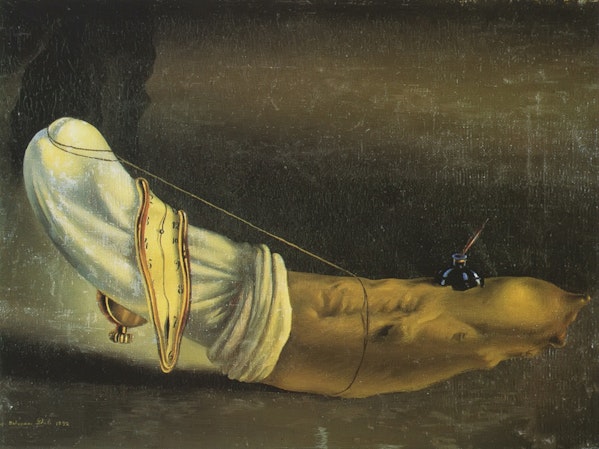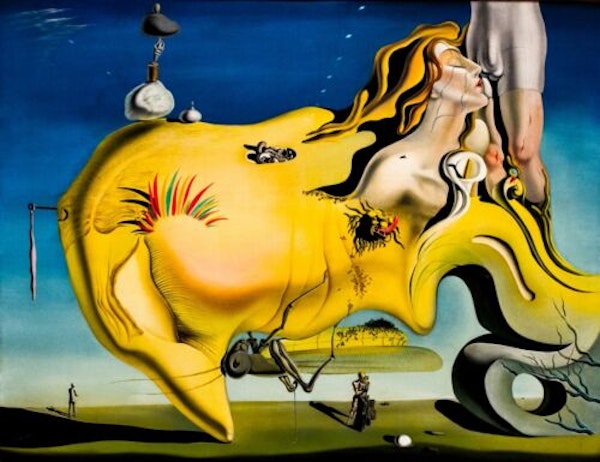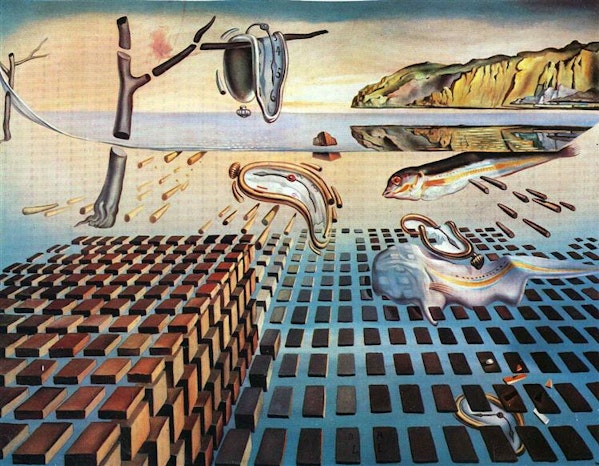
The Adhesion of Memory, 1931
One of Salvador Dali's most famous works is "The Adhesion of Memory," which depicts a melted and softened clock.
This early work is a masterpiece that best expresses Dali's own identity.
It is also a masterpiece of Surrealism, which combined impossible motifs to create an unrealistic painting.
At first glance, however, it can seem unintelligible, and it seems to have the power to make the viewer's gaze cross with its own.
We will explain what Dali wanted to express and what it means in terms of art history.
What kind of work is "The Adhesion of Memory"?
The Fixation of Memory is an oil painting created by Salvador Dali in 1931. It is one of Dali's earliest and most representative works.
It is currently housed in the collection of the Museum of Modern Art in New York.
It is also known as "The Soft Clock" or "The Melting Clock.
This work was first exhibited in 1932. In 1934, an anonymous donor gave it to the Museum of Modern Art (MoMA) in New York.
Representation of Anxiety and Desire, Inner Impulses
Contrast between flexibility and rigidity = simultaneous expression of anxiety and desire
According to Dali, the melting clock depicted in "Memory's Fixation" was inspired by the melting of Camembert cheese in the kitchen of Gala, the artist's partner and model. The basic creative source is this one case, which shows the painter's ability to sublimate improvisation into his work.
It is also believed that "memory," the past, is represented by the clock, which represents time.
Dali's passion for something paranoid and obsessive to the point of melting away memories. It seems as if anxiety and desire took shape at the same time.
The realization of a dream scene - Freud's dream judgment.
And the word "obsession" also describes the artist's strange fervor well.
Dali's fixation was the realization of a dream-like, delusional scene.
This can be thought of as a realization of Dali's own sexual perversions, as determined by Sigmund Freud's dream judgments.
The art critic Tatsuhiko Shibuya, who introduced the idea of surrealism to Japan, commented on Dali as follows: "Some of Dali's paintings are perhaps not so much realistic as they are in their reality.
Dali probably has a strange ambivalence between his intellectual attachment to solid objects with definite shapes and his unconscious attachment to squishy objects with no definite shape.
Paranoid = Critical Method
Dali's method has been called "paranoid-critical method.
Although he draws inspiration for his paintings from his own sexual anguish, he does not simply create works driven by passion.
He creates fantastical images while at the same time objectively putting them into form.
This contradictory yet fundamental attitude of Dali's work has been named "paranoid-critical method" by himself.
Why was Dali attracted to polar opposites?
Dali's ED Problem
Why was Dali so fixated on the "hard" and the "soft"?
In fact, he had a long-standing fear of women from an early age.
Perhaps his fear of women was intensified when his father showed him graphic images of syphilis (a type of venereal disease that causes grotesque tissue necrosis as it progresses) when he was a child.
Representations found in "Catalan Bread" and "The Great Masturbator
It is said that Dali had ED because of these traumas, and his obsession with "hard" and "soft" objects may have been rooted in his ED problem.
Other works such as "Catalan Bread" and "The Great Masturbator" also show expressions that could be attributed to Dali's own sexual impotence.

Catalan Bread, 1932

The Great Masturbator, 1929
Space-Time Distortion and Einstein
Commonalities with General Relativity
Art critics have often noted that "The Adhesion of Memory" shows distortions of time and space.
Some researchers believe that the artist incorporated Einstein's "general theory of relativity" into his work.
General relativity is a scientific theory that proposes that the speed of light is the only invariant natural quantity, and that according to it, light and time expand and contract when moving at high speeds or in spaces with large gravitational forces.
According to art historian Dawn Eise, "Memory Stuck" symbolizes a distortion of space-time, depicting various suspended moments in time (present progressive and past) simultaneously.
Future-Present-Past time axis
The three clocks depicted in "The Adhesion of Memory" all represent different moments in time.
They may represent a state in which the three time axes of future, present, and past are intermingled.
Such a concept seems to have been born out of Dali's commitment to the Surrealist movement, of which he was a central figure.
It could be said that the principles of Surrealism form the basis of Dali's work.
Incidentally, when asked about scientific issues by physicist Ilya Prigogine, Dali said that science was not the main point of inspiration for him, but that he was merely interested in the melting of Camembert cheese.
The mysterious creature in the center
Self-portrait-like motif
What is interesting about "Memory's Fixation" is the mysterious white, dumpling-skin-like creature placed in the center. What is the meaning behind this?
This mysterious white creature, which looks like a washed-up whale or a giant squid, also appears in "The Great Comforter," painted in the same year, 1929.
This could be the artist's own self-portrait, which appears in many of Dali's works.
Dali's self-portrait of the white creature (the Great Comforter) is sleeping with its eyes closed. It appears to be dreaming with its eyes closed.
In "Memory's Fixation," Dali seems to identify himself with a slowly melting Camembert cheese. How did Dali superimpose himself on the cheese?
The Meaning of "Melting
The phenomenon of "melting" evokes for Dali something internal, subtle, and unconscious: physical and sexual arousal, decay, and disintegration.
On the other hand, the phenomenon of "hardness" or "hardening" would have been associated with images of solidity, such as intellectual action and solid ground.
The Mystery of the Ants in the Orange Clock
What do the ants mean?
The orange clock in the lower left corner has many ants. In Salvador Dali's work, the presence of ants symbolizes the concept of "decay.
This image must have been deeply rooted in Dali's imagination, as he witnessed an insect being eaten by ants when he was five years old.
For the young Dali, the sight of an insect with its shell hollowed out and its contents gone was a shocking sight. As a result, ants became for Dali a visual metaphor for death and decay and, in a perverse way, a metaphor for sexual impulses.
Other works on the theme of ants and decay include "Retrospective Female Figure.
_Salvador_Dal%C3%AD.jpg?w=600&h=696)
Retrospective of a Woman, 1933
A view of his native Catalonia
The craggy, rocky landscape in the upper right corner of the painting is a scene from Cape Creus in Dali's hometown of Catalonia, Spain.
Many of the landscapes that appear in Dali's works are influenced by Catalonia.
The view from Dali's parents' villa at the foot of the Pani Mountains must have influenced him.
In "Memory's Fixation," researchers believe that the shadow of the Panis, Catalonia's most iconic mountain range, is in the foreground, with Cape Creus and its rugged coastline in the background.
The incorporation of nature and other backgrounds, as well as Dali's personal sexual and spiritual perversions as described above, add to the timeless appeal of "The Adherence of Memory.

Catalonia in Summer
Dali's Change in "The Disintegration of Memory's Fixation
Dali's Changing Views
In 1954, Dali created "The Collapse of Memory's Fixation," a remake of "The Fixation of Memory," which was based on "The Fixation of Memory.
Between these two versions, we see a clear transition in Dali's own conception. The first painting was created in the midst of the "Freudian era" due to Dali's fascination with the dream analysis pioneered by Sigmund Freud. Sexual perversions and sexual urges are directly projected onto the motifs in the paintings. By the time the latter was painted in the 1950s, Dali's hidden creative source had become atomic age science. As the artist later said, "In the age of Surrealism, the paintings were not about the science of the atomic age.
During the Surrealist period, I wanted to create an image of the inner world, the marvelous world of my father Freud. I succeeded in that. Today, however, the external world, the world of physics, has transcended the world of psychology. Today my father is the theoretical physicist Dr. Heisenberg."

The Collapse of Memory's Adhesion, 1952 - 1954.
TRiCERA ART members receive a variety of benefits and preferences.
- Discounts, including members-only secret sales and coupons
- Create your own collection by registering your favorite artists
- Receive updates on popular artists, exhibitions, and events
- Receive a weekly newsletter with selected art
- Personal Assessment to find out what kind of art you like.
Please register as a member for free and receive the latest information.
Free Membership Registration
For TRiCERA inquiries, please contact us here
If you have any questions about TRiCERA or requests for custom-made orders, please feel free to contact us through our official LINE.